2014 年 12 月英语六级真题试卷(第 3 套)
Part I
Writing
(30 minutes)
Directions:Forthispart,youareallowed30minutestowriteanessaybasedonthe
picture below. You should start your essay with a brief description of
the picture and then discuss whether technology is indispensable in
education.Youshouldgivesoundargumentstosupportyourviewsandwrite
at least 150 words but no more than 200words.
Listening
Part II
说明:2014 年 12 月六级真题全国共考了两套听力。本套(即第三套)的听力内容与第二套
的完全一样,只是选项的顺序不一样而已,故在本套中不再重复给出。
Comprehension
(30 minutes)
Reading
(40 minutes)
Comprehension
Part III
Section A
Directions:In this section, there is a passage with ten blanks. You are required
toselectonewordforeachblankfromalistofchoicesgiveninaword
bank following the passage. Read the passage through carefully before
making yourchoices.Eachchoice inthebank isidentified bya letter.
PleasemarkthecorrespondingletterforeachitemonAnswerSheet2with
asinglelinethroughthecentre.Youmaynotuseanyofthewordsinthe
bank more than once.
Questions 36 to 45 are based on the following passage.
It was 10 years ago, on a warm July night, that a newborn lamb took her first
breath in a small shed in Scotland. From the outside, she looked no different from
thousands of other sheep born on 36 farms. But Dolly, as the world soon came to realize,
�
was no 37 lamb. She was cloned from a single cell of an adult female sheep, 38
long-held scientific dogma that had declared such a thing biologically impossible.
A decade later, scientists are starting to come to grips with just how different
Dolly was. Dozens of animals have been cloned since that first lamb—mice, cats,
cows and, most recently, a dog—and it’s becoming 39 clear that they are all, in
one way or another, defective.
It’s 40 to think of clones as perfect carbon copies of the original. It turns
out, though, that there are various degrees of genetic 41. That may come as a shock
to people who have paid thousands of dollars to clone a pet cat only to discover
that the baby cat looks and behaves 42 like their beloved pet—with a different-
color coat of fur, perhaps, or a 43 different attitude toward its human hosts.
And these are just the obvious differences. Not only are clones 44 from the
original template(模板)by time, but they are also the product of an unnatural
molecular mechanism that turns out not to be very good at making 45 copies. In fact,
the process can embed small flaws in the genes of clones that scientists are only
now discovering.
注意:此部分试题请在答题卡 2 上作答。
A) abstract
B) completely
C) deserted
D) duplication
E) everything
F) identical
G) increasingly
H) miniature
I) nothing
J) ordinary
K) overturning
L) separated
M) surrounding
N) systematically
O) tempting
Section B
Directions:In this section, you are going to read a passage with ten statements
attached to it. Eachstatement contains information given in one of the
paragraphs.Identifytheparagraphfromwhichtheinformationisderived.
Youmaychooseaparagraphmorethanonce.Eachparagraphismarkedwith
a letter. Answer the questions by marking the corresponding letter on
Answer Sheet 2.
High School Sports Aren’t Killing Academics
A) In this month’s Atlantic cover article, “The Case Against High-School Sports,”
Amanda Ripley argues that school-sponsored sports programs should be seriously
cut. She writes that, unlike most countries that outperform the United States
on international assessments, American schools put too much of an emphasis on
athletics. “Sports are embedded in American schools in a way they are not almost
anywhere else,” she writes. “Yet this difference hardly ever comes up in
domestic debates about America’s international mediocrity ( 平 庸 ) in
education.”
B) American student-athletes reap many benefits from participating in sports, but
�
the costs to the schools could outweigh their benefits, she argues. In particular,
Ripley contends that sports crowd out the academic missions of schools: America
should learn from South Korea and Finland and every other country at the top level
of international test scores, all of whom emphasize athletics far less in school.
“Even in eighth grade, American kids spend more than twice the time Korean kids
spend playing sports,” she writes, citing a 2010 study published in the Journal
of Advanced Academics.
C) It might well be true that sports are far more rooted in American high schools
than in other countries. But our reading of international test scores finds no
support for the argument against school athletics. Indeed, our own research and
that of others lead us to make the opposite case. School-sponsored sports appear
to provide benefits that seem to increase, not detract (减少) from, academic
success.
D) Ripley indulges a popular obsession ( 痴 迷 ) with international test score
comparisons, which show wide and frightening gaps between the United States and
other countries. She ignores, however, the fact that states vary at least as much
in test scores as do developed countries. A 2011 report from Harvard University
shows that Massachusetts produces math scores comparable to South Korea and
Finland, while Mississippi scores are closer to Trinidad and Tobago. Ripley’s
thesis about sports falls apart in light of this fact. Schools in Massachusetts
provide sports programs while schools in Finland do not. Schools in Mississippi
may love football while in Tobago interscholastic sports are nowhere near as
prominent. Sports cannot explain these similarities in performance. They can’t
explain international differences either.
E) If it is true that sports undermine the academic mission of American schools,
we would expect to see a negative relationship between the commitment to athletics
and academic achievement. However, the University of Arkansas’s Daniel Bowen
and Jay Greene actually find the opposite. They examine this relationship by
analyzing schools’ sports winning percentages as well as student-athletic
participation rates compared to graduation rates and standardized test score
achievement over a five-year period for all public high schools in Ohio.
Controlling for student poverty levels, demographics ( 人 口 统 计 状 况 ), and
district financial resources, both measures of a school’s commitment to
athletics are significantly, positively related to lower dropout rates as well
as higher test scores.
F) On-the-field success and high participation in sports is not random—it requires
focus and dedication to athletics. One might think this would lead schools
obsessed with winning to deemphasize academics. Bowen and Greene’s results
contradict
seemingly
counterintuitive ( 与 直 觉 相 反 的 ) result is that success in sports programs
explanation
argument.
for
this
that
A
likely
�
actually facilitates or reflects greater social capital within a school’s
community.
G) Ripley cites the writings of renowned sociologist James Coleman, whose research
in education was groundbreaking. Coleman in his early work held athletics in
contempt, arguing that they crowded out schools’ academic missions. Ripley
quotes his 1961 study, The Adolescent Society, where Coleman writes, “Altogether,
the trophy (奖品) case would suggest to the innocent visitor that he was entering
an athletic club, not an educational institution.”
H) However, in later research he would show how the success of schools is highly
dependent on what he termed social capital, “the norms, the social networks,
and the relationships between adults and children that are of value for the
child’s growing up.”
I) According to a 2013 evaluation conducted by the Crime Lab at the University of
Chicago, a program called Becoming a Man—Sports Edition creates lasting
improvements in the boys’ study habits and grade point averages. During the first
year of the program, students were found to be less likely to transfer schools
or be engaged in violent crime. A year after the program, participants were less
likely to have had an encounter with the juvenile justice system.
J) If school-sponsored sports were completely eliminated tomorrow, many American
students would still have opportunities to participate in organized athletics
elsewhere, much like they do in countries such as Finland, Germany, and South Korea.
The same is not certain when it comes to students from more disadvantaged
backgrounds. In an overview of the research on non-school based after-school
programs, researchers find that disadvantaged children participate in these
programs at significantly lower rates. They find that low-income students have
less access due to challenges with regard to transportation, non- nominal fees,
and off-campus safety. Therefore, reducing or eliminating these opportunities
would most likely deprive disadvantaged students of the benefits from athletic
participation, not least of which is the opportunity to interact with positive
role models outside of regular school hours.
K) Another unfounded criticism that Ripley makes is bringing up the stereotype that
athletic coaches are typically lousy (蹩脚的) classroom teachers. “American
principals, unlike the vast majority of principals around the world, make many
hiring decisions with their sports teams in mind, which does not always end well
for students,” she writes. Educators who seek employment at schools primarily
for the purpose of coaching are likely to shirk (推卸) teaching responsibilities,
the argument goes. Moreover, even in the cases where the employee is a teacher
first and athletic coach second, the additional responsibilities that come with
coaching likely come at the expense of time otherwise spent on planning, grading,
�
and communicating with parents and guardians.
L) The data, however, do not seem to confirm this stereotype. In the most rigorous
study on the classroom results of high school coaches, the University of
Arkansas’s Anna Egalite finds that athletic coaches in Florida mostly tend to
perform just as well as their non-coaching counterparts, with respect to raising
student test scores. We do not doubt that teachers who also coach face serious
tradeoffs that likely come at the expense of time they could dedicate to their
academic obligations. However, as with sporting events, athletic coaches gain
additional opportunities for communicating and serving as mentors (导师) that
potentially help students succeed and make up for the costs of coaching
commitments.
M) If schools allow student-athletes to regularly miss out on instructional time
for the sake of traveling to athletic competitions, that’s bad. However, such
issues would be better addressed by changing school and state policies with regard
to the scheduling of sporting events as opposed to total elimination. If the
empirical evidence points to anything, it points towards school-sponsored sports
providing assets that are well worth the costs.
N) Despite negative stereotypes about sports culture and Ripley’s presumption that
academics and athletics are at odds with one another, we believe that the greater
body of evidence shows that school-sponsored sports programs appear to benefit
students. Successes on the playing field can carry over to the classroom and vice
versa (反之亦然). More importantly, finding ways to increase school communities’
social capital is imperative to the success of the school as a whole, not just
the athletes.
注意:此部分试题请在答题卡 2 上作答。
46. Students from low-income families have less access to off-campus sports
programs.
47. Amanda Ripley argues that America should learn from other countries that rank
high in international tests and lay less emphasis on athletics.
48. According to the author, Amanda Ripley fails to note that students’ performance
in exams varies from state to state.
49. Amanda Ripley thinks that athletic coaches are poor at classroom instruction.
50. James Coleman’s later research makes an argument for a school’s social capital.
51. Researchers find that there is a positive relationship between a school’s
commitment to athletics and academic achievements.
52. A rigorous study finds that athletic coaches also do well in raising students’
test scores.
53. According to an evaluation, sports programs contribute to students’ academic
performance and character building.
54. Amanda Ripley believes the emphasis on school sports should be brought up when
trying to understand why American students are mediocre.
�
55. James Coleman suggests in his earlier writings that school athletics would
undermine a school’s image.
Section C
Directions:Thereare2passagesinthissection.Eachpassageisfollowedbysome
questions or unfinished statements. For each of them there are four
choicesmarkedA),B),C)andD).Youshoulddecideonthebestchoiceand
markthecorrespondingletteronAnswerSheet2withasinglelinethrough
the centre.
Passage One
Questions 56 to 60 are based on the following passage.
It is easy to miss amid the day-to-day headlines of global economic recession,
but there is a less conspicuous kind of social upheaval (剧变) underway that is fast
altering both the face of the planet and the way human beings live. That change is
the rapid acceleration of urbanization. In 2008, for the first time in human history,
more than half the world’s population was living in towns and cities. And as a
recently published paper shows, the process of urbanization will only accelerate
in the decades to come—with an enormous impact on biodiversity and potentially on
climate change.
As Karen Seto, the lead author of the paper, points out, that the wave of
urbanization isn’t just about the migration of people into urban environments, but
about the environments themselves becoming bigger to accommodate all those people.
The rapid expansion of urban areas will have a huge impact on biodiversity hotspots
and on carbon emissions in those urban areas.
Humans are the ultimate invasive species—when they move into new territory,
they often displace the wildlife that was already living there. And as land is cleared
for those new cities — especially in the dense tropical forests—carbon will be
released into the atmosphere as well. It’s true that as people in developing nations
move from the countryside to the city, the shift may reduce the pressure on land,
which could in turn be good for the environment. This is especially so in desperately
poor countries, where residents in the countryside slash and bum forests each growing
season to clear space for farming. But the real difference is that in developing
nations, the move from rural areas to cities often leads to an accompanying increase
in income—and that increase leads to an increase in the consumption of food and
energy, which in turns causes a rise in carbon emissions. Getting enough to eat and
enjoying the safety and comfort of living fully on the grid is certainly a good thing
— but it does carry an environmental price.
The urbanization wave can’t be stopped—and it shouldn’t be. But Seto’s paper
does underscore the importance of managing that transition. If we do it the right
way, we can reduce urbanization’s impact on the environment. “There’s an enormous
opportunity here, and a lot of pressure and responsibility to think about how we
urbanize,” says Seto. “One thing that’s clear is that we can’t build cities the
way we have over the last couple of hundred years. The scale of this transition won’t
allow that.” We’re headed towards an urban planet no matter what, but whether it
�
becomes heaven or hell is up to us.
注意:此部分试题请在答题卡 2 上作答。
56. What issue does the author try to draw people’s attention to?
A) The shrinking biodiversity worldwide.
B) The rapid increase of world population.
C) The ongoing global economic recession.
D) The impact of accelerating urbanization.
57. In what sense are humans the ultimate invasive species?
A) They are much greedier than other species.
B) They are a unique species born to conquer.
C) They force other species out of their territories.
D) They have an urge to expand their living space.
58. In what way is urbanization in poor countries good for the environment?
A) More land will be preserved for wildlife.
B) The pressure on farmland will be lessened.
C) Carbon emissions will be considerably reduced.
D) Natural resources will be used more effectively.
59. What does the author say about living comfortably in the city?
A) It incurs a high environmental price.
B) It brings poverty and insecurity to an end.
C) It causes a big change in people’s lifestyle.
D) It narrows the gap between city and country.
60. What can be done to minimize the negative impact of urbanization according to
Seto?
A) Slowing down the speed of transition.
B) Innovative use of advanced technology.
C) Appropriate management of the process.
D) Enhancing people’s sense of responsibility.
Passage Two
Questions 61 to 65 are based on the following passage.
When Harvard student Mark Zuckerherg launched the facebook.com in Feb. 2004,
even he could not imagine the forces it would let loose. His intent was to connect
college students. Facebook, which is what this Web site rapidly evolved into, ended
up connecting the world.
To the children of this connected era, the world is one giant social network.
They are not bound - as were previous generations of humans - by what they were taught.
They are only limited by their curiosity and ambition. During my childhood, all
knowledge was local. You learned everything you knew from your parents, teachers,
preachers, and friends.
�
With the high-quality and timely information at their fingertips, today’s
children are rising above the fears and biases of their parents. Adults are also
participating in this revolution. India’s normally tame middle class is speaking
up against social ills. Silicon Valley executives are being shamed into adding women
to their boards. Political leaders are marshalling the energy of millions for
elections and political causes. All of this is being done with social media
technologies that Facebook and its competitors set free.
As does every advancing technology, social media has created many new problems.
It is commonly addictive and creates risks for younger users. Social media is used
by extremists in the Middle East and elsewhere to seek and brainwash recruits. And
it exposes us and our friends to disagreeable spying. We may leave our lights on
in the house when we are on vacation, but through social media we tell criminals
exactly where we are, when we plan to return home, and how to blackmail (敲诈) us.
Governments don’t need informers any more. Social media allows government agencies
to spy on their own citizens. We record our thoughts, emotions, likes and dislikes
on Facebook; we share our political views, social preferences, and plans. We post
intimate photographs of ourselves. No spy agency or criminal organization could
actively gather the type of data that we voluntarily post for them.
The marketers are also seeing big opportunities. Amazon is trying to predict
what we will order. Google is trying to judge our needs and wants based on our
social-media profiles. We need to be aware of the risks and keep working to alleviate
the dangers.
Regardless of what social media people use, one thing is certain: we are in a
period of accelerating change. The next decade will be even more amazing and
unpredictable than the last. Just as no one could predict what would happen with
social media in the last decade, no one can accurately predict where this technology
will take us. I am optimistic, however, that a connected humanity will find a way
to uplift itself.
注意:此部分试题请在答题卡 2 上作答。
61. What was the purpose of Facebook when it was first created?
A) To help students connect with the outside world.
B) To bring university students into closer contact.
C) To help students learn to live in a connected era.
D) To combine the world into an integral whole.
62. What difference does social media make to learning?
A) Local knowledge and global knowledge will merge.
B) Students will become more curious and ambitious.
C) People are able to learn wherever they travel.
D) Sources of information are greatly expanded.
63. What is the author’s greatest concern with social media technology?
A) Individual and organizations may use it for evil purposes.
B) Government will find it hard to protect classified information.
�
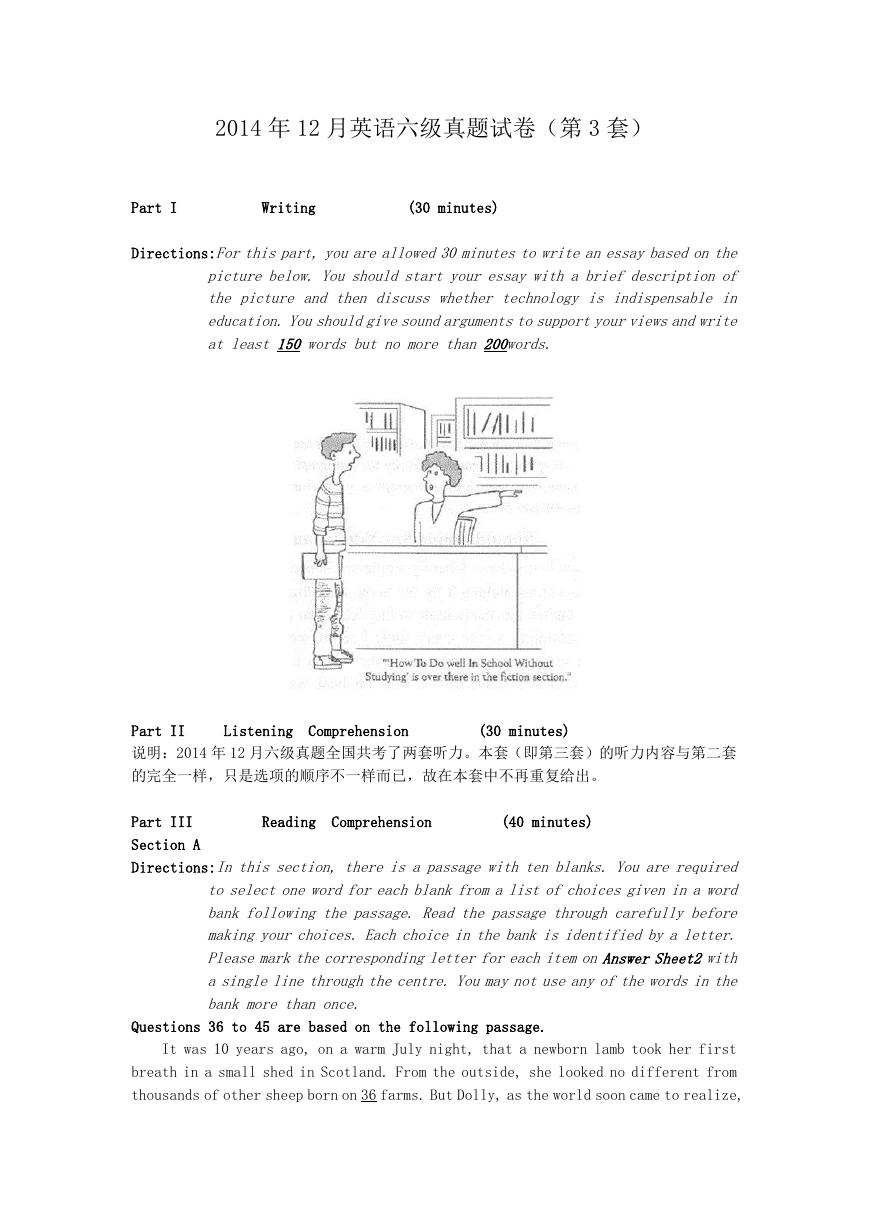
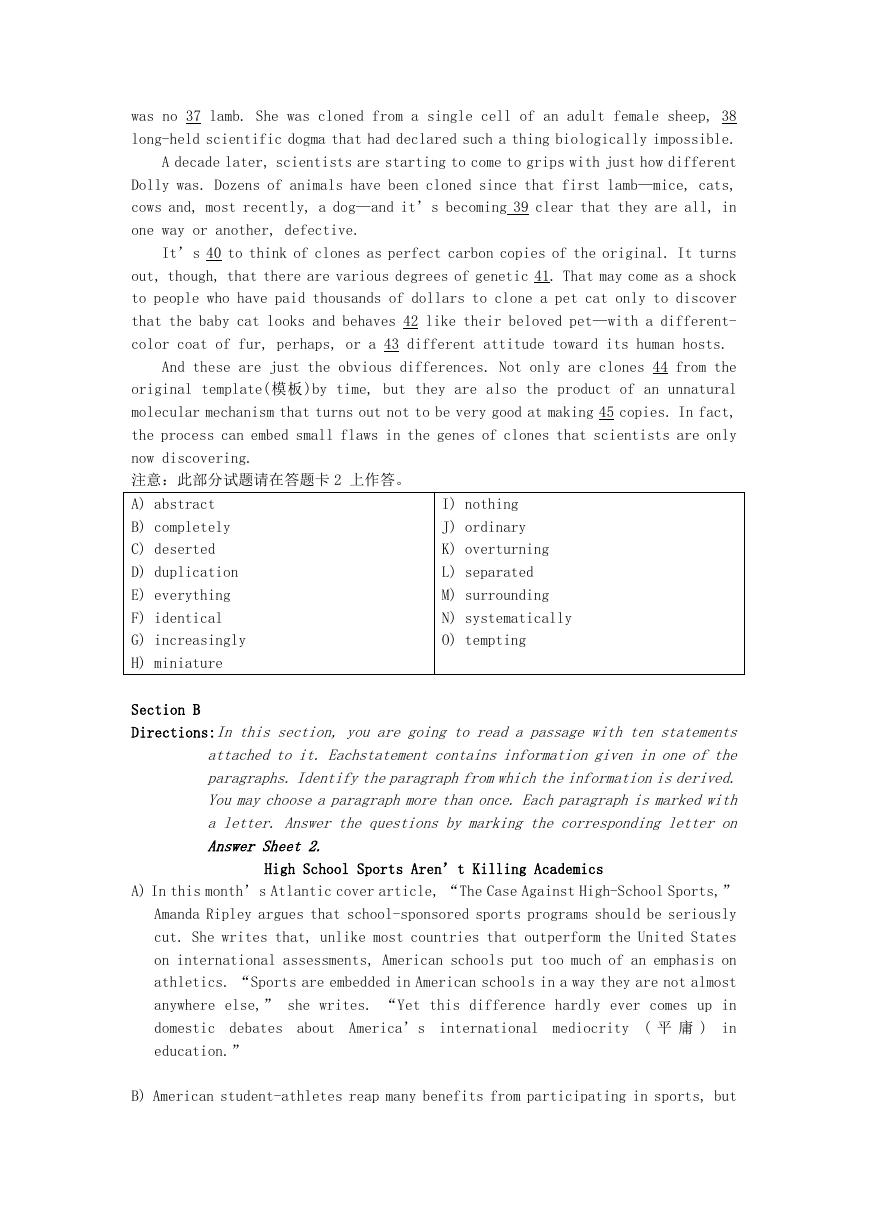
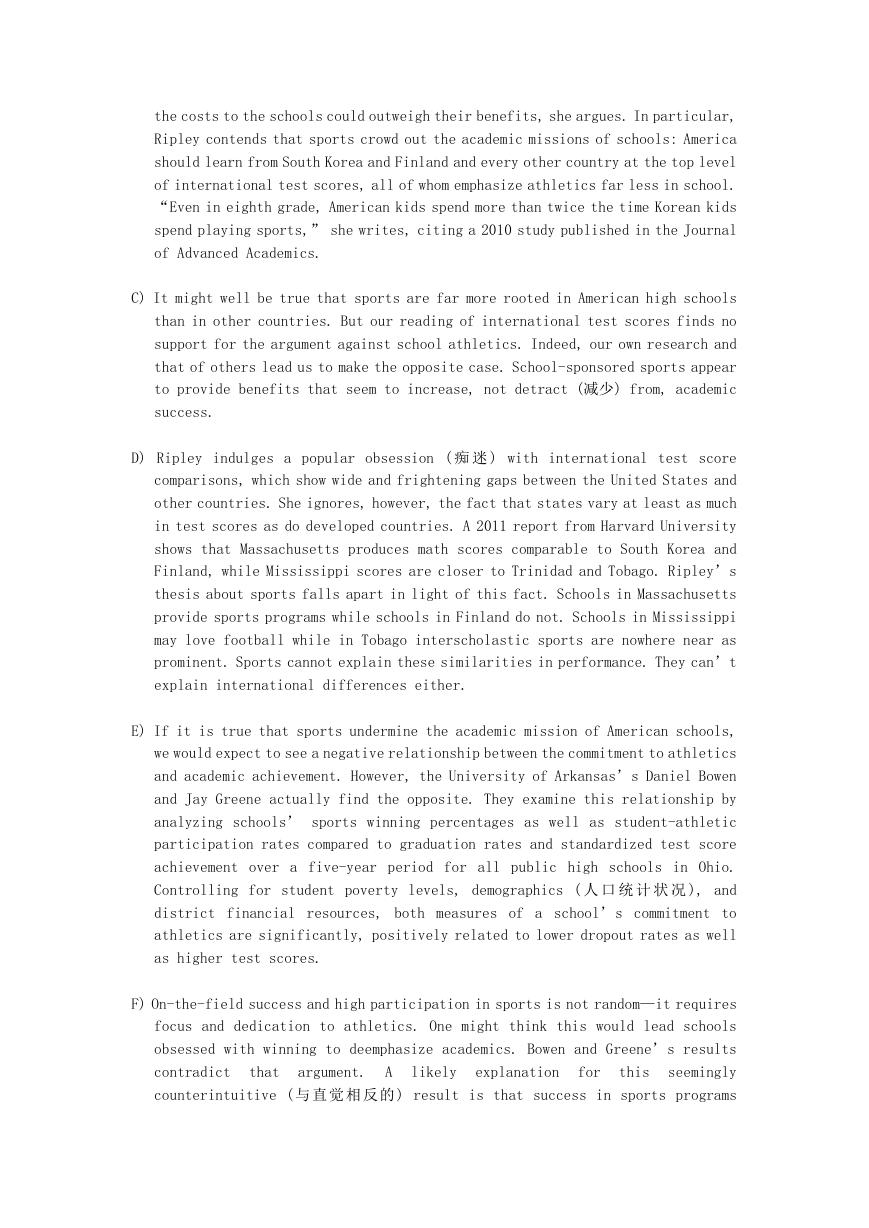
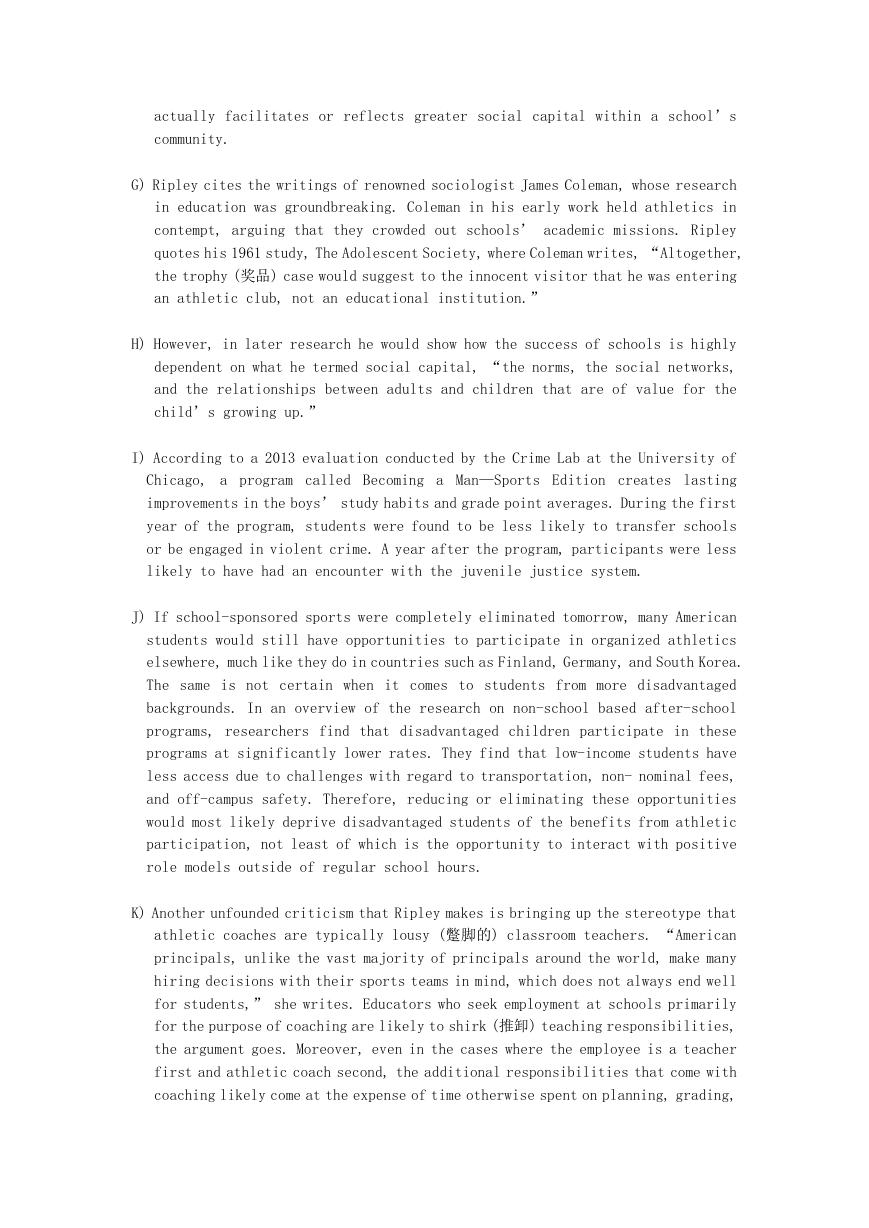

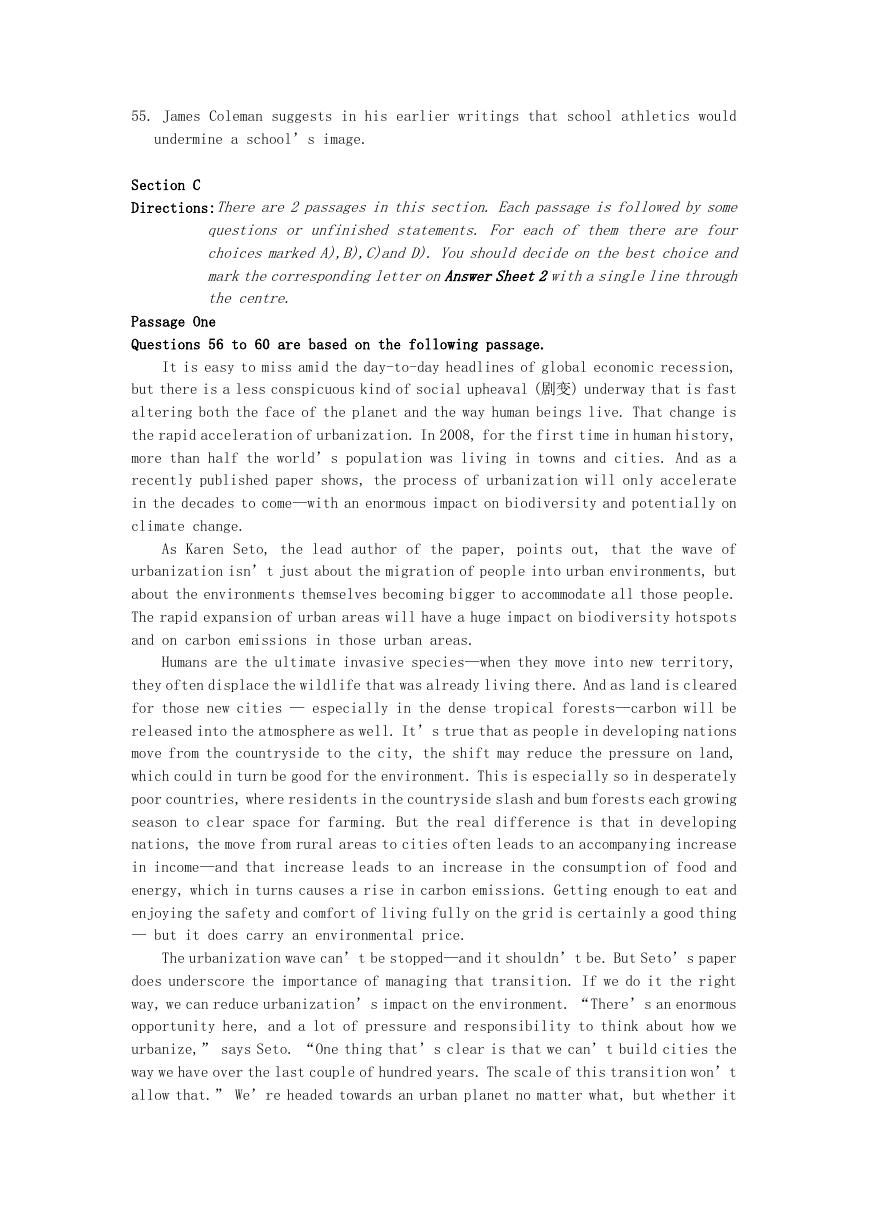
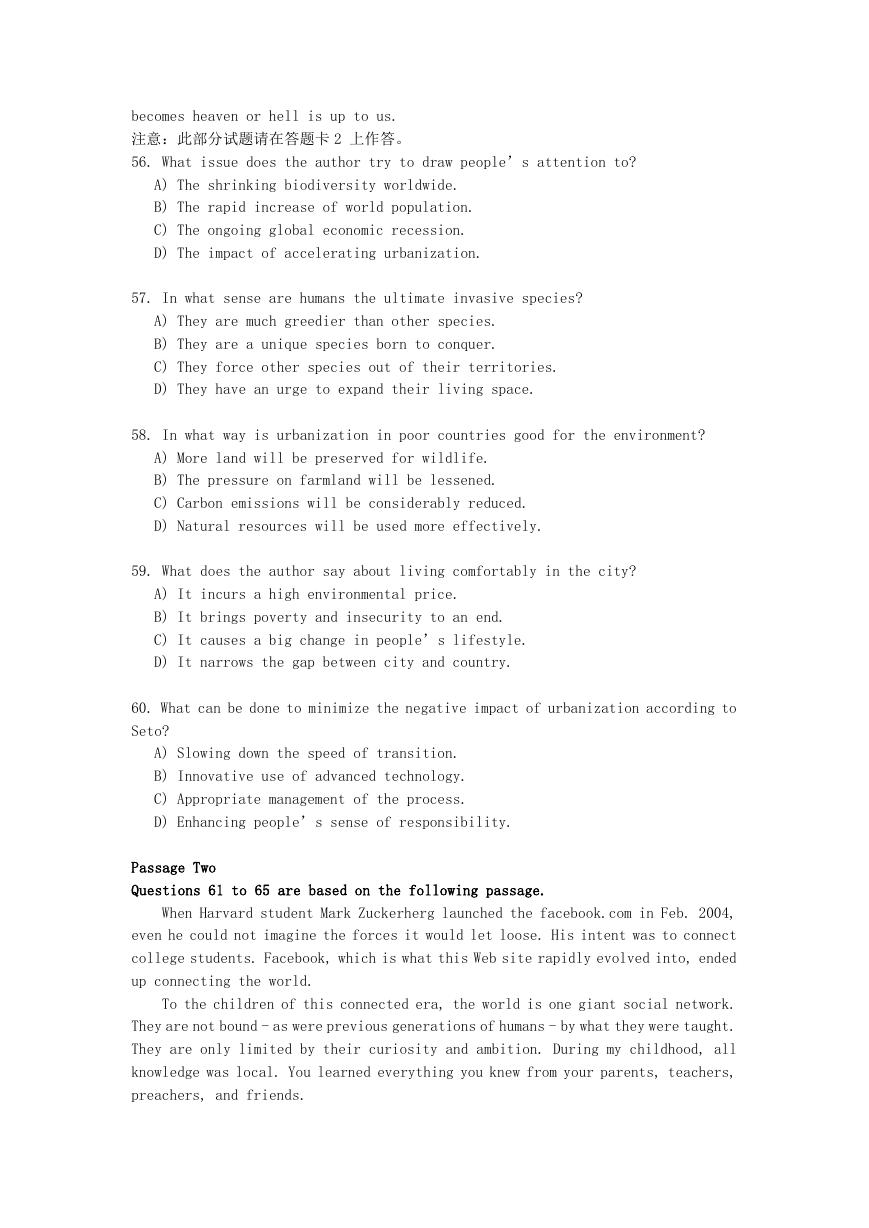









 2023年江西萍乡中考道德与法治真题及答案.doc
2023年江西萍乡中考道德与法治真题及答案.doc 2012年重庆南川中考生物真题及答案.doc
2012年重庆南川中考生物真题及答案.doc 2013年江西师范大学地理学综合及文艺理论基础考研真题.doc
2013年江西师范大学地理学综合及文艺理论基础考研真题.doc 2020年四川甘孜小升初语文真题及答案I卷.doc
2020年四川甘孜小升初语文真题及答案I卷.doc 2020年注册岩土工程师专业基础考试真题及答案.doc
2020年注册岩土工程师专业基础考试真题及答案.doc 2023-2024学年福建省厦门市九年级上学期数学月考试题及答案.doc
2023-2024学年福建省厦门市九年级上学期数学月考试题及答案.doc 2021-2022学年辽宁省沈阳市大东区九年级上学期语文期末试题及答案.doc
2021-2022学年辽宁省沈阳市大东区九年级上学期语文期末试题及答案.doc 2022-2023学年北京东城区初三第一学期物理期末试卷及答案.doc
2022-2023学年北京东城区初三第一学期物理期末试卷及答案.doc 2018上半年江西教师资格初中地理学科知识与教学能力真题及答案.doc
2018上半年江西教师资格初中地理学科知识与教学能力真题及答案.doc 2012年河北国家公务员申论考试真题及答案-省级.doc
2012年河北国家公务员申论考试真题及答案-省级.doc 2020-2021学年江苏省扬州市江都区邵樊片九年级上学期数学第一次质量检测试题及答案.doc
2020-2021学年江苏省扬州市江都区邵樊片九年级上学期数学第一次质量检测试题及答案.doc 2022下半年黑龙江教师资格证中学综合素质真题及答案.doc
2022下半年黑龙江教师资格证中学综合素质真题及答案.doc